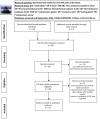The modified Lapidus fusion: a systematic review of biomechanical studies
- PMID: 37097047
- PMCID: PMC10155126
- DOI: 10.1530/EOR-22-0069
The modified Lapidus fusion: a systematic review of biomechanical studies
Abstract
Purpose: The biomechanical characteristics of different techniques to perform the modified Lapidus procedure are controversial, discussing the issue of stability, rigidity, and compression forces from a biomechanical point of view. The aim of this systematic review was to investigate the available options to identify whether there is a procedure providing superior biomechanical results.
Methods: A comprehensive literature search was performed by screening PubMed, Embase, and Cochrane databases until September 2021. There was a wide heterogeneity of the available data in the different studies. Load to failure, stiffness, and compression forces were summarized and evaluated.
Results: Seventeen biomechanical studies were retrieved - ten cadaveric and seven polyurethane foam (artificial bone) studies. Fixation methods ranged from the classic crossed screw approach (n = 5) to plates (dorsomedial and plantar) with or without compression screws (n = 11). Newer implants such as intramedullary stabilization screws (n = 1) and memory alloy staples (n = 2) were investigated.
Conclusion: The two crossed screws construct is still a biomechanical option; however, according to this systematic review, there is strong evidence that a plate-screw construct provides superior stability especially in combination with a compression screw. There is also evidence about plate position and low evidence about compression screw position. Plantar plates seem to be advantageous from a biomechanical point of view, whereas compression screws could be better when positioned outside the plate. Overall, this review suggests the biomechanical advantages of using a combination of locking plates with a compression screw.
Keywords: crossed screw fixation; first metatarsocuneiform arthrodesis; modified Lapidus procedure; plantar plate fixation.
Conflict of interest statement
The authors declare that there is no conflict of interest that could be perceived as prejudicing the impartiality of the research reported.
Figures





Similar articles
-
Stability of medial locking plate and compression screw versus two crossed screws for lapidus arthrodesis.Foot Ankle Int. 2010 Feb;31(2):158-63. doi: 10.3113/FAI.2010.0158. Foot Ankle Int. 2010. PMID: 20132754
-
Biomechanical comparison of a locking plate with intraplate compression screw versus locking plate with plantar interfragmentary screw for Lapidus arthrodesis: a cadaveric study.J Foot Ankle Surg. 2013 May-Jun;52(3):339-42. doi: 10.1053/j.jfas.2013.02.012. J Foot Ankle Surg. 2013. PMID: 23621977
-
Biomechanical Comparison of Low-Profile Contoured Locking Plate With Single Compression Screw to Fully Threaded Compression Screws for First MTP Fusion.Foot Ankle Int. 2019 Jul;40(7):836-844. doi: 10.1177/1071100719837524. Epub 2019 Mar 17. Foot Ankle Int. 2019. PMID: 30880450
-
Evaluating the Biomechanical Integrity of Various Constructs Utilized for First Metatarsophalangeal Joint Arthrodesis: A Systematic Review.Materials (Basel). 2023 Oct 5;16(19):6562. doi: 10.3390/ma16196562. Materials (Basel). 2023. PMID: 37834699 Free PMC article. Review.
-
A Systematic Review of Screw and Suture Button Glenoid Augmentation Constructs.Orthop J Sports Med. 2023 Oct 12;11(10):23259671231186429. doi: 10.1177/23259671231186429. eCollection 2023 Oct. Orthop J Sports Med. 2023. PMID: 37840899 Free PMC article. Review.
Cited by
-
Revision Surgery for a Foot With Loss of Correction After Modified Lapidus Procedure: A Case Report.Cureus. 2025 Mar 10;17(3):e80372. doi: 10.7759/cureus.80372. eCollection 2025 Mar. Cureus. 2025. PMID: 40213716 Free PMC article.
-
Surgical Techniques for Lapidus Arthrodesis: Approaches, Indications, and Outcomes.J Clin Med. 2025 Jun 28;14(13):4591. doi: 10.3390/jcm14134591. J Clin Med. 2025. PMID: 40648964 Free PMC article. Review.
References
-
- Truslow W. Metatarsus primus VARUS or hallux valgus? Bone and Joint Surgery 19257. Available at: https://journals.lww.com/jbjsjournal/Fulltext/1925/07010/METATARSUS_PRIM.... - PubMed
-
- Kleinberg S. The Operative cure of hallux valgus and bunions. American Journal of Surgery 19321575–81. (10.1016/S0002-9610(3291000-9) - DOI
-
- Lapidus PW. Operative correction of metatarsus primus Varus in hallux valgus. Surgery, Gynecology and Obstetrics 193458183–191.
-
- Lapidus PW. A quarter of a century of experience with the operative correction of the metatarsus varus primus in hallux valgus. Bulletin of the Hospital for Joint Diseases 195617404–421. - PubMed
Publication types
LinkOut - more resources
Full Text Sources

